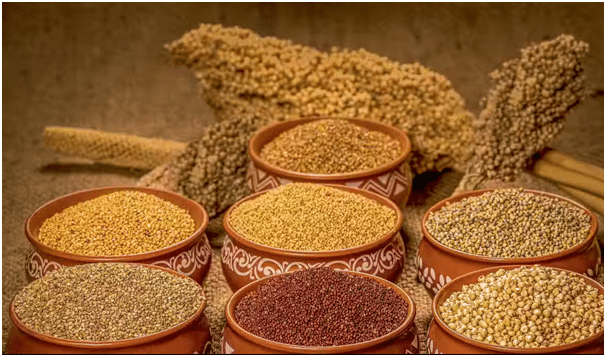The nutritional Value of Millets
Context: The U.N. Food and Agriculture Organisation (FAO) has declared 2023 to be the ‘International Year of Millets’, giving these crops a shot in the arm even as countries worldwide are looking to them for their ability to grow in environmental conditions that the climate crisis is rendering more common. Millets are becoming more popular in India as well because of their low input requirements and high nutritional density, both of which are valuable for a country whose food security is expected to face significant challenges in the coming decades.
What are millets?
- Millets are fundamentally grasses. They are cultivated worldwide, but especially in the tropical parts of Africa and Asia, as cereal crops.
- Some of the more common varieties include pearl millet ( Cenchrus americanus), barnyard millet ( Echinochloa utilis), finger millet ( Eleusine coracana), and foxtail millet ( Setaria italica).
- There is both palaeontological and textual evidence to indicate that millets were being cultivated in the Indian subcontinent five millennia ago.
- According to the Agricultural and Processed Foods Development Authority, India is the world’s largest producer of millets.
- In 2021-2022, the country accounted for 40.51% of the world’s pearl millet production and 8.09% of sorghum.
- Within the country, pearl millet made up 60% of all the millet production, sorghum 27%, and ragi 11%.
- Sorghum ( Sorghum bicolor), adlay millet ( Coix lacryma-jobi), and teff ( Eragrostis tef) – among others – are some grasses that differ in some respects from the millets but are grouped together with them.
Why are they sought after?
- Millets have two broad features that render them attractive: their nutritional value being comparable to that of the major extant food crops (and better on some counts) and the ability of millet crops to reliably withstand harsh, resource-poor conditions.
- They are drought-tolerant, adapted to growing in warm weather, and require low moisture (axiomatically, they are particularly efficient consumers of water) and loamy soil.
- They don’t grow well in water-logged or extremely dry soil, such as might occur after heavy rainfall or particularly bad droughts, respectively.
- millets have the reliability upper hand over crops like rice and maize with more drought-like conditions expected in many parts of the world, including the newly realised prospect of ‘flash droughts’.
Are millets nutritious?
- The nutritional content of millets includes carbohydrates, proteins, fibre, amino acids, and various minerals.
- Different millet varieties have different nutrient profiles. For example, pearl millet – one of the oldest cultivated varieties – has been found to have higher protein content than rice, maize, and sorghum, while being comparable to that of barley.
- According to various studies, foxtail millet is rich in the amino acid lysine; finger millet has more crude fibre than wheat and rice; proso millet has a significant amount of the amino acids leucine, isoleucine, and methionine; and overall, millets have been found to be important sources of micronutrients and phytochemicals.
| Practice Question
1. How millets can help in tackling the food security challenges in the world? |




